Ana-Ethnographic Representation: Early Modern Pueblo Painters, Scientific Colonialism, and Tactics of Refusal
Abstract
1. Ana-Ethnography and Tactics of Refusal
2. The Crescencio Set
3. Protecting Knowledge against Scientific Colonialism
This position is held by most Pueblo communities, including San Ildefonso, which have a long and fraught history with anthropology—a field that historically had a particular lust for seeking out and sharing esoteric information. As Simpson (2007, p. 69) writes, anthropology marks a colonial space of “knowing and contention with serious implications for Indigenous peoples”.People outside have the idea that knowledge should be shared. That’s what universities are built around. But at Zuni we don’t think that way. Some knowledge should be protected and not shared. There are things in Zuni you can know, and things you can’t. And there are certain people who deserve to be the keepers of that knowledge. It’s a privilege, and the rest of us respect them for that.43
4. Ethno-Archaeological Labor
5. Crescencio’s Tiles
Funding
Acknowledgments
Conflicts of Interest
References
- Adams, Tony E., Stacy Holman Jones, and Carolyn S. Ellis. 2015. Autoethnography: Understanding Qualitative Research. New York: Oxford University Press. [Google Scholar]
- Allen, Paula Gunn. 1990. Special Problems in Teaching Leslie Marmon Silko’s ‘Ceremony’. American Indian Quarterly 14: 379–86. [Google Scholar] [CrossRef]
- Allen, Paula Gunn. 1991. Grandmothers of the Light: A Medicine Woman’s Sourcebook. Boston: Beacon Press. [Google Scholar]
- Anthes, Bill. 2006. Native Moderns: American Indian Painting, 1940–1960. Durham: Duke University Press. [Google Scholar]
- Bandelier, Adolph F., and Edgar L. Hewett. 1973. Indians of the Rio Grande Valley. New York: Cooper Square Publishers. First published 1937. [Google Scholar]
- Bernstein, Bruce, and W. Jackson Rushing, III. 1995. Modern by Tradition: American Indian Painting in the Studio Style. Santa Fe: Museum of New Mexico Press. [Google Scholar]
- Blair, Mary Ellen. 2008. A Life Well Led: The Biography of Barbara Freire-Marreco Aitken, British Anthropologist. Santa Fe: Sunstone Press. [Google Scholar]
- Boast, Robin. 2011. Neocolonial Collaboration: Museum as Contact Zone Revisited. Museum Anthropology 34: 56–70. [Google Scholar] [CrossRef]
- Brandt, Elizabeth A. 1980. On Secrecy and the Control of Knowledge: Taos Pueblo. In Secrecy: A Cross-Cultural Perspective. Edited by Stanton K. Tefft. New York: Human Sciences Press, pp. 123–46. [Google Scholar]
- Brody, J.J. 1971. Indian Painters and White Patrons. Albuquerque: University of New Mexico Press. [Google Scholar]
- Brody, J.J. 1997. Pueblo Indian Painting: Tradition and Modernism in New Mexico, 1900–1930. Santa Fe: School of American Research Press. [Google Scholar]
- Brooks, James F. 2016. Mesa of Sorrows: A History of the Awat’ovi Massacre. New York: W. W. Norton. [Google Scholar]
- Brown, Michael F. 2003. Who Owns Native Culture? Cambridge: Harvard University Press. [Google Scholar]
- Burkhart, Brian Yazzie. 2004. What the Coyote and Thales Can Teach Us: An Outline of American Indian Epistemology. In American Indian Thought: Philosophical Essays. Edited by Anne Waters. Malden: Blackwell Publishing, pp. 15–26. [Google Scholar]
- Cajete, Gregory. 1994. Look to the Mountain: An Ecology of Indigenous Education. Durango: Kivaki Press. [Google Scholar]
- Cajete, Gregory. 2000. Native Science: Natural Laws of Interdependence. Santa Fe: Clear Light Publishers. [Google Scholar]
- Chang, Heewon. 2008. Autoethnography as Method. Walnut Creek: Left Coast Press. [Google Scholar]
- Chapman, Kenneth M. 1916. Graphic Art of the Cave Dwellers. El Palacio 3: 37–41. [Google Scholar]
- Chase, Katherin L. 2002. Indian Painters of the Southwest: The Deep Remembering. Santa Fe: School of American Research Press. [Google Scholar]
- Chavez, Cynthia L. 2001. Negotiated Representations: Pueblo Artists and Culture. Ph.D. dissertation, University of New Mexico, Albuquerque, NM, USA. [Google Scholar]
- Christian Science Monitor. 1931. American Indian Paintings. Christian Science Monitor, December 5, 6. [Google Scholar]
- Clifford, James. 1986. Introduction: Partial Truths. In Writing Culture: The Poetics and Politics of Ethnography. Edited by James Clifford and George E. Marcus. Berkeley: University of California Press, pp. 1–26. [Google Scholar]
- Clifford, James. 1988. The Predicament of Culture: Twentieth-Century Ethnography, Literature, and Art. Cambridge: Harvard University Press. [Google Scholar]
- Clifford, James, and George E. Marcus, eds. 1986. Writing Culture: The Poetics and Politics of Ethnography. Berkeley: University of California Press. [Google Scholar]
- Colwell, Chip. 2017. Plundered Skulls and Stolen Spirits: Inside the Fight to Reclaim Native America’s Culture. Chicago: University of Chicago Press. [Google Scholar]
- Colwell-Chanthaphonh, Chip. 2010. Living Histories: Native Americans and Southwestern Archaeology. Lanham: AltaMira Press. [Google Scholar]
- Colwell-Chanthaphonh, Chip. 2011. Sketching Knowledge: Quandaries in the Mimetic Reproduction of Pueblo Ritual. American Ethnologist 38: 451–67. [Google Scholar] [CrossRef]
- Cordova, V.F. 2004. Approaches to Native American Philosophy. In American Indian Thought: Philosophical Essays. Edited by Anne Waters. Malden: Blackwell Publishing, pp. 27–33. [Google Scholar]
- Curtis, Edward S. 1926. The North American Indian. Norwood: Plimpton Press, vol. 17. [Google Scholar]
- D., B.P. 1942. Indian Artists Visit Museum. El Palacio 49: 128–29. [Google Scholar]
- de Certeau, Michel. 1984. The Practice of Everyday Life. Berkeley: University of California Press. [Google Scholar]
- Deloria, Vine, Jr. 1988. Custer Died for Your Sins: An Indian Manifesto, 2nd ed. Norman: University of Oklahoma Press. [Google Scholar]
- Deloria, Vine, Jr. 1994. God Is Red: A Native View of Religion. Golden: Fulcrum Publishing. [Google Scholar]
- Deloria, Vine, Jr. 2004. Philosophy and the Tribal Peoples. In American Indian Thought: Philosophical Essays. Edited by Anne Waters. Malden: Blackwell Publishing, pp. 3–11. [Google Scholar]
- Deloria, Vine, Jr., and Daniel R. Wildcat. 2001. Power and Place: Indian Education in America. Golden: Fulcrum Publishing. [Google Scholar]
- Denzin, Norman K. 1989. Interpretive Biography. Newbury Park: Sage Publications. [Google Scholar]
- Dietrich, Margretta S. 1936. Their Culture Survives. Indians at Work 3: 18–23. [Google Scholar]
- Dillingham, Rick. 1994. Fourteen Families in Pueblo Pottery. Albuquerque: University of New Mexico Press. [Google Scholar]
- Dobkins, Rebecca J. 1997. Memory and Imagination: The Legacy of Maidu Indian Artist Frank Day. Oakland: Oakland Museum of California. [Google Scholar]
- Dobkins, Rebecca J. 2000. Art and Autoethnography: Frank Day and the Uses of Anthropology. Museum Anthropology 24: 22–29. [Google Scholar] [CrossRef]
- Dozier, Edward P. 1970. The Pueblo Indians of North America. Prospect Heights: Waveland Press. [Google Scholar]
- DuFour, John. 2004. Ethics and Understanding. In American Indian Thought: Philosophical Essays. Edited by Anne Waters. Malden: Blackwell Publishing, pp. 34–41. [Google Scholar]
- Dunn, Dorothy. 1951. The Development of Modern American Painting in the Southwest and Plains Area. El Palacio 58: 331–53. [Google Scholar]
- Dunn, Dorothy. 1955. America’s First Painters. National Geographic Magazine 107: 349–78. [Google Scholar]
- Dunn, Dorothy. 1968. American Indian Painting of the Southwest and Plains Areas. Albuquerque: University of New Mexico Press. [Google Scholar]
- Dutton, Bertha P. 1942. Alfredo Montoya—Pioneer Artist. El Palacio 49: 143–44. [Google Scholar]
- El Palacio. 1918. Art of Crecencio Martinez. El Palacio 5: 59. [Google Scholar]
- El Palacio. 1919. Museum Chronology. El Palacio 6: 135. [Google Scholar]
- Ellingson, Laura L., and Carolyn Ellis. 2008. Autoethnography as Constructionist Project. In Handbook of Constructionist Research. Edited by James A. Holstein and Jaber F. Gubrium. New York: The Guilford Press, pp. 445–65. [Google Scholar]
- Elliott, Melinda. 1987. The School of American Research: A History, the First Eighty Years. Santa Fe: School of American Research. [Google Scholar]
- Ellis, Carolyn. 2004. The Ethnographic I: A Methodological Novel about Autobiography. Walnut Creek: AltaMira Press. [Google Scholar]
- Ellis, Carolyn S., and Arthur Bochner. 2000. Autoethnography, Personal Narrative, Reflexivity: Researcher as Subject. In The Handbook of Qualitative Research. Edited by Norman K. Denzin and Yvonna Lincoln. Thousand Oaks: Sage Publications, pp. 733–68. [Google Scholar]
- Ellis, Carolyn, Tony E. Adams, and Arthur P. Bochner. 2011. Autoethnography: An Overview. Forum: Qualitative Social Research 12. Available online: http://nbn-resolving.de/urn:nbn:de:0114-fqs1101108 (accessed on 4 March 2019).
- Fewkes, Jesse Walter. 1969. Hopi Katchinas Drawn by Native Artists, Smithsonian Bureau of American Ethnology Annual Report, 1903. Glorieta: Rio Grande Press. [Google Scholar]
- Fowles, Severin, and Barbara J. Mills. 2017. On History in Southwest Archaeology. In The Oxford Handbook of Southwest Archaeology. Edited by Severin Fowles and Barbara J. Mills. Oxford: Oxford University Press, pp. 3–71. [Google Scholar]
- Fry, Aaron. 2008. Local Knowledge and Art Historical Methodology: A New Perspective on Awa Tsireh and the San Ildefonso Easel Painting Movement. Hemisphere: Visual Cultures of the Americas 1: 46–61. [Google Scholar]
- Gruber, Jacob. 1970. Ethnographic Salvage and the Shaping of Anthropology. American Anthropologist 72: 1289–99. [Google Scholar] [CrossRef]
- Hartley, Marsden. 1920. Red Man Ceremonials: An American Plea for American Esthetics. Art and Archaeology 9: 7–14. [Google Scholar]
- Hewett, Edgar L. 1904. Archeology of the Pajarito Park, New Mexico. American Anthropologist 6: 629–59. [Google Scholar] [CrossRef]
- Hewett, Edgar L. 1909. The Excavations at El Rito De Los Frijoles in 1909. American Anthropologist 11: 651–73. [Google Scholar] [CrossRef][Green Version]
- Hewett, Edgar L. 1916. America’s Archaeological Heritage. Art and Archaeology 4: 257–66. [Google Scholar]
- Hewett, Edgar L. 1918. Crescencio Martinez—Artist. El Palacio 5: 67–69. [Google Scholar]
- Hewett, Edgar L. 1922. Native American Artists. Art and Archaeology 13: 103–12. [Google Scholar]
- Highwater, Jamake. 1976. Song from the Earth: American Indian Painting. Boston: Little, Brown and Company for the New York Graphic Society. [Google Scholar]
- Highwater, Jamake. 1986. Controversy in Native American Art. In The Arts of the North American Indian: Native Traditions in Evolution. Edited by Edwin L. Wade and Carol Haralson. New York: Hudson Hills Press in association with Philbrook Art Center, pp. 223–42. [Google Scholar]
- Hodge, F.W. 1924. Rites of the Pueblo Indians: F. W. Hodge Denies There Is Anything Revolting or Immoral About Them and Attributes Reports to the Indians’ Desire to Fool the Whites. New York Times, October 26, X12. [Google Scholar]
- Horton, Jessica L. 2015. A Cloudburst in Venice: Fred Kabotie and the U.S. Pavilion of 1932. American Art 29: 54–81. [Google Scholar] [CrossRef]
- Ishii, Lomayumtewa C. 2002. Hopi Culture and a Matter of Representation. Indigenous Nations Studies Journal 3: 33–52. [Google Scholar]
- Jacobs, Margaret D. 1996. Making Savages of Us All: White Women, Pueblo Indians, and the Controversy over Indian Dances in the 1920s. Frontiers: A Journal of Women Studies 17: 178–209. [Google Scholar] [CrossRef]
- Jacobs, Margaret D. 1999. Engendered Encounters: Feminism and Pueblo Cultures, 1879–18934. Lincoln: University of Nebraska Press. [Google Scholar]
- Jantzer-White, Marilee. 1994. Tonita Peña (Quah Ah), Pueblo Painter: Asserting Identity through Continuity and Change. American Indian Quarterly 18: 369–82. [Google Scholar] [CrossRef]
- Kabotie, Fred, and Bill Belknap. 1977. Fred Kabotie, Hopi Indian Artist: An Autobiography Told with Bill Belknap. Flagstaff: Museum of Northern Arizona with Northland Press. [Google Scholar]
- Kelly, Lawrence C. 1983. The Assault on Assimilation: John Collier and the Origins of Indian Policy Reform. Albuquerque: University of New Mexico Press. [Google Scholar]
- Lange, Charles H. 1968. Cochiti: A New Mexico Pueblo, Past and Present. Carbondale: Southern Illinois University Press. First published 1959. [Google Scholar]
- Lewis, Diane. 1973. Anthropology and Colonialism. Current Anthropology 14: 581–602. [Google Scholar] [CrossRef]
- Lucic, Karen, and Bruce Bernstein. 2008. In Pursuit of the Ceremonial: The Laboratory of Anthropology’s ‘Master Collection’ of Zuni Pottery. Journal of the Southwest 50: 1–102. [Google Scholar] [CrossRef]
- Lyon, Luke. 1988. History of Prohibition of Photography of Southwestern Indian Ceremonies. In Reflections: Papers on Southwestern Culture History in Honor of Charles H. Lange. Edited by Anne V. Poore. Santa Fe: Ancient City Press, pp. 238–72. [Google Scholar]
- Martineau, Joel. 2001. Autoethnography and Material Culture: The Case of Bill Reid. Biography 24: 242–58. [Google Scholar] [CrossRef]
- McGeough, Michelle. 2009. Through Their Eyes: Indian Painting in Santa Fe, 1918–1945. Santa Fe: Wheelwright Museum of the American Indian. [Google Scholar]
- Messier, Kim, and Pat Messier. 2007. Hopi and Pueblo Tiles: An Illustrated History. Tucson: Rio Nuevo Publishers. [Google Scholar]
- Mihesuah, Devon A. 1998. Natives and Academics: Researching and Writing about American Indians. Lincoln: University of Nebraska Press. [Google Scholar]
- Miller, Angela L., Janet C. Berlo, Bryan J. Wolf, and Jennifer L. Roberts. 2007. American Encounters: Art, History, and Cultural Identity. Upper Saddle River: Pearson Prentice Hall. [Google Scholar]
- Mills, Barbara J. 2002. Acts of Resistance: Zuni Ceramics, Social Identity, and the Pueblo Revolt. In Archaeologies of the Pueblo Revolt: Identity, Meaning, and Renewal in the Pueblo World. Edited by Robert W. Preucel. Albuquerque: University of New Mexico Press, pp. 85–98. [Google Scholar]
- Mobley-Tanaka, Jeannette L. 2002. Crossed Cultures, Crossed Meanings: The Manipulation of Ritual Imagery in Early Historic Pueblo Resistance. In Archaeologies of the Pueblo Revolt: Identity, Meaning, and Renewal in the Pueblo World. Edited by Robert W. Preucel. Albuquerque: University of New Mexico Press, pp. 77–84. [Google Scholar]
- Morell, Virginia. 2007. The Zuni Way. Smithsonian Magazine. April. Available online: https://www.smithsonianmag.com/history/the-zuni-way-150866547/ (accessed on 2 July 2019).
- Munson, Marit K. 2006. Creating the Codex Hopiensis: Jesse Walter Fewkes and Hopi Artists, 1899–1900. American Indian Art Magazine 31: 70–83. [Google Scholar]
- Ono, Akiko. 2011. Who Owns the ‘De-Aboriginalised’ Past? Ethnography Meets Photography: A Case Study of Bundjalung Pentecostalism. In Ethnography and the Production of Anthropological Knowledge. Edited by Yasmine Musharbash and Marcus Barber. Canberra: Australian National University, pp. 51–68. [Google Scholar]
- Ortiz, Alfonso. 1969. The Tewa World: Space, Time, Being, and Becoming in a Pueblo Society. Chicago: University of Chicago Press. [Google Scholar]
- Ortiz, Alfonso. 1972. Ritual Drama and the Pueblo World View. In New Perspectives on the Pueblos. Edited by Alfonso Ortiz. Albuquerque: University of New Mexico Press, pp. 135–61. [Google Scholar]
- Ortiz, Alfonso. 1994. The Pueblo. Edited by Frank W. Porter, III. New York: Chelsea House. [Google Scholar]
- Pandey, Triloki Nath. 1972. Anthropologists at Zuni. Proceedings of the American Philosophical Society 116: 321–37. [Google Scholar]
- Parsons, Elsie Clews. 1939. Pueblo Indian Religion. 2 vols. Chicago: University of Chicago Press, Vol. 1. [Google Scholar]
- Pearlstone, Zena, ed. 2001. Katsina: Commodified and Appropriated Images of Hopi Supernaturals. Los Angeles: UCLA Fowler Museum of Cultural History. [Google Scholar]
- Pearlstone, Zena. 2011. Hopi Doll Look-Alikes: An Extended Definition of Inauthenticity. American Indian Quarterly 35: 579–608. [Google Scholar] [CrossRef]
- Penney, David W., and Lisa A. Roberts. 1999. America’s Pueblo Artists: Encounters on the Borderlands. In Native American Art in the Twentieth Century. Edited by W. Jackson Rushing, III. London and New York: Routledge, pp. 21–38. [Google Scholar]
- Phillips, Ruth B. 1998. Trading Identities: The Souvenir in Native North American Art from the Northeast, 1700–1900. Seattle: University of Washington Press. Montreal: McGill-Queen’s University Press. [Google Scholar]
- Phillips, Ruth B. 1999. Nuns, Ladies, and the ‘Queen of the Huron’: Appropriating the Savage in Nineteenth-Century Huron Tourist Art. In Unpacking Culture: Art and Commodity in Colonial and Postcolonial Worlds. Edited by Ruth B. Phillips and Christopher B. Steiner. Berkeley: University of California Press, pp. 33–50. [Google Scholar]
- Pratt, Mary Louise. 1986. Fieldwork in Common Places. In Writing Culture: The Poetics and Politics of Ethnography. Edited by James Clifford and George E. Marcus. Berkeley: University of California Press, pp. 27–50. [Google Scholar]
- Pratt, Mary Louise. 1991. Arts of the Contact Zone. Profession 1991: 33–40. [Google Scholar]
- Pratt, Mary Louise. 1992. Imperial Eyes: Travel Writing and Transculturation. New York: Routledge. [Google Scholar]
- Reed-Danahay, Deborah. 1997. Introduction. In Auto/Ethnography: Rewriting the Self and the Social. Edited by Deborah Reed-Danahay. Oxford: Berg Publishers, pp. 1–17. [Google Scholar]
- Rickard, Jolene. 1995. Sovereignty: A Line in the Sand. Aperture 139: 50–59. [Google Scholar]
- Rickard, Jolene. 2011. Visualizing Sovereignty in the Time of Biometric Sensors. South Atlantic Quarterly 110: 465–86. [Google Scholar] [CrossRef]
- Rushing, W. Jackson, III. 2018. Generations in Modern Pueblo Painting: The Art of Tonita Peña and Joe Herrera. Norman: Fred Jones Jr. Museum of Art, University of Oklahoma. [Google Scholar]
- Sando, Joe S. 1992. Pueblo Nations: Eight Centuries of Pueblo Indian History. Santa Fe: Clear Light Publishers. [Google Scholar]
- Santa Fe New Mexican. 1915a. Human Sacrifice Tale Groundless Says F. C. Wilson. Santa Fe New Mexican, May 3. [Google Scholar]
- Santa Fe New Mexican. 1915b. All Imagination Says Lonergan, of Human Sacrifice by the Pueblo. Santa Fe New Mexican, April 23. [Google Scholar]
- Schaaf, Gregory. 2000. Pueblo Indian Pottery: 750 Artist Biographies, C. 1800–Present. American Indian Art Series; Santa Fe: CIAC Press. [Google Scholar]
- Scott, Sascha. 2013. Awa Tsireh and the Art of Subtle Resistance. Art Bulletin 95: 597–622. [Google Scholar] [CrossRef]
- Scott, Sascha. 2015. A Strange Mixture: The Art and Politics of Painting Pueblo Indians. Norman: University of Oklahoma Press. [Google Scholar]
- Secretary of the Smithsonian Institution. 1911. Report of the Secretary of the Smithsonian Institution: For the Year Ending June 30, 1914; Washington, DC: Washington Government Printing Office.
- Seymour, Tryntje Van Ness. 1988. When the Rainbow Touches Down: The Artists and Stories Behind the Apache, Navajo, Rio Grande Pueblo and Hopi Paintings in the William and Leslie Van Ness Denman Collection. Phoenix: Heard Museum. [Google Scholar]
- Simpson, Audra. 2007. On Ethnographic Refusal: Indigeneity, ‘Voice’ and Colonial Citizenship. Junctures 9: 67–80. [Google Scholar]
- Simpson, Audra. 2014. Mohawk Interruptus: Political Life across the Borders of Settler States. Durham: Duke University Press. [Google Scholar]
- Smith, Linda Tuhiwai. 1999. Decolonizing Methodologies: Research and Indigenous Peoples. London: Zed Books. [Google Scholar]
- Snead, James E. 2001. Ruins and Rivals: The Making of Southwest Archaeology. Tucson: University of Arizona Press. [Google Scholar]
- Spinden, Herbert J. 1930. Indian Artists of the Southwest. International Studio 95: 49–51. [Google Scholar]
- Stevens, Tilly E. (a pen name for Matilde Coxe Stevenson). 1887. The Religious Life of the Zuñi Child. In Fifth Annual Report of the Bureau of Ethnology to the Secretary of the Smithsonian Institution, 1883–1884. Washington, DC: Smithsonian Government Printing Office, pp. 533–55. [Google Scholar]
- Suina, Joseph H. 1992. Pueblo Secrecy: Result of Intrusions. New Mexico Magazine 70: 60–63. [Google Scholar]
- Sweet, Jill D. 2004. Dances of the Tewa Pueblo Indians: Expressions of New Life, 2nd ed. Santa Fe: School for Advanced Research Press. [Google Scholar]
- Szabó, Zoltán Gendler. 2017. Compositionality. In The Stanford Encyclopedia of Philosophy. Edited by Edward N. Zalta. Stanford: The Metaphysics Research Lab, Stanford University. Available online: https://plato.stanford.edu/archives/sum2017/entries/compositionality/ (accessed on 12 March 2019).
- Tanner, Clara Lee. 1973. Southwest Indian Painting: A Changing Art, 2nd ed. Tucson: University of Arizona Press. [Google Scholar]
- Thomas, Nicholas. 1994. Colonialism’s Culture: Anthropology, Travel and Government. Princeton: Princeton University Press. [Google Scholar]
- Warrior, Robert Allen. 1995. Tribal Secrets: Recovering American Indian Intellectual Traditions. Minneapolis: University of Minnesota Press. [Google Scholar]
- Washington Post. 1915a. Human Sacrifices, She Says, Are Still Offered by Tewa Indians. Washington Post, January 18, 7. [Google Scholar]
- Washington Post. 1915b. Human Sacrifices by Indians: Tewas Offer up Women and Children in Rites. Says Mrs. Stevenson. Washington Post, April 17, 2. [Google Scholar]
- Wenger, Tisa. 2009. We Have a Religion: The 1920s Pueblo Indian Dance Controversy and American Religious Freedom. Chapel Hill: University of North Carolina Press. [Google Scholar]
- Whiteley, Peter. 1993. The End of Anthropology (at Hopi)? Journal of the Southwest 35: 125–57. [Google Scholar]
- Whitt, Laurie Anne. 1995. Indigenous Peoples and the Cultural Politics of Knowledge. In Issues in Native American Cultural Identity. Edited by Michael K. Green. New York: Peter Lang, pp. 223–71. [Google Scholar]
- Wilson, L.L.W. 1917. This Year’s Work at Otowi. El Palacio 4: 87. [Google Scholar]
- Wilson, L.L.W. 1918. In Memoriam: Crescencio Martinez. El Palacio 5: 33. [Google Scholar]
- Wyckoff, Lydia L. 1996. Vision and Voices: Native American Painting from the Philbrook Museum of Art. Tulsa: Philbrook Museum of Art. [Google Scholar]
| 1 | Twenty paintings from the Crescencio Set can be identified at the Museum of Indian Arts and Culture (MIAC) in Santa Fe. MIAC also houses at least twelve tiles by Crescencio, which can be dated by a reference to them in (El Palacio 1918). On the commission, also see (Hewett 1918). |
| 2 | On the meaning and significance of Pueblo ceremonial dances, see (Ortiz 1972, pp. 35–161; 1969; Sweet 2004). |
| 3 | Alfredo Montoya sold paintings to outsiders at least as early as 1911, as will be discussed later in this paper. Montoya, Awa Tsireh, and Tonita Peña are among the painters who attended the San Ildefonso Day School. Students were encouraged to draw and paint images of Pueblo life by teachers Esther Hoyt (1900 to 1907) and Elizabeth Richards (1909 and after). The role school teachers played in fostering modern Pueblo painting has been well documented (Dunn 1968, pp. 201, 204–5; Tanner 1973, pp. 67, 84; Bernstein and Rushing 1995; Brody 1997, pp. 37–40, 82–83; McGeough 2009, pp. 17–41). |
| 4 | Elizabeth DeHuff encouraged a handful of students to paint ceremonial dances in early 1919 and first exhibited the paintings at the school’s library in early March 1919; see letter from Elizabeth DeHuff to her mother, 11 March 1919, Elizabeth Willis DeHuff Family Papers, 1883–1981 (MSS99), Center for Southwest Research, University of New Mexico (hereafter CSWR), box 10, folder 25. Hewett was taken with the show and opened an exhibition of the paintings at the Museum of Fine Arts on 29 March 1919; see (El Palacio 1919). The Museum of Fine Arts, which is part of the Museum of New Mexico, was dedicated in 1917. |
| 5 | On patronage and national exhibitions and markets, see (Brody 1971, 1997). On international exhibitions, see (Horton 2015). |
| 6 | Notably, first-generation painter Tonita Peña did not work for Hewett as a laborer, almost certainly because of her gender. She was born at San Ildefonso and moved to Cochiti in 1905 after the death of her mother. She asked Hewett if she could live and work at the museum in 1921, but her request was denied. See letters from Peña to Lansing Bloom, 19 September 1921 (box 4, folder 4) and Bloom to Peña, 26 October 1921 (box 4, folder 5), Edgar L. Hewett Collection, Fray Angélico Chávez History Library, Santa Fe, New Mexico. |
| 7 | These concerns and acts of resistance are well documented and are discussed later in this paper with respect to the Hopi and Santa Clara communities. For other examples, see (Pandey 1972; Lucic and Bernstein 2008, pp. 11, 14–19, 33–41; Colwell 2017, pp. 17–18, 23–24). |
| 8 | On “scientific colonialism”, see the landmark essay (Lewis 1973, pp. 583–85). Anthropology’s rootedness in colonialism has been widely discussed, including in (Clifford and Marcus 1986; Clifford 1988; Thomas 1994; Smith 1999; Colwell-Chanthaphonh 2010). |
| 9 | Hewett (1922, p. 110) argues that Pueblo paintings are of ethnographic (and aesthetic) interest. Reflecting on her reasons for asking her Native students to paint, DeHuff wrote, “eight years ago after seeing my first Indian ceremonial, enthusiasm demanded that I secure a reproduction of it in colors. However, how could such a thing be had? After days of pondering, I canvassed the rooms at the Santa Fe Indian School for children, who showed especial aptitude for drawing and crayon coloring”; see Elizabeth DeHuff, “American Primitives in Art”, unpublished manuscript, Elizabeth Willis DeHuff Family Papers, Center for Southwest Research, box 6, folder 3. In a similar vein, Tanner (1973, pp. 133–34) wrote that the fine details Tonita Peña’s paintings make them “the same excellent ethnological records that are the case with so much of this [Pueblo] Indian art”. Brody (1997, p. 157) writes that Awa Tsireh’s early paintings for Hewett were objective, descriptive, and “ethnographically detailed”, arguing that the artist moved to a more subjective mode as he matured, a claim Brody extends to other Pueblo painters too (189). |
| 10 | Velino Shije Herrera quoted in “Well-known Indian Painter Thanks to Dr. Edgar Hewett”, The Santa Fe New Mexican, 19 December 1944, 2. Kabotie quoted in (Kabotie and Belknap 1977, p. 44). Similar statements by twentieth-century Pueblo artists can be found in (Seymour 1988, pp. 147, 162–63, 168). |
| 11 | On “autoethnography” with respect to Pueblo painting, see (Penney and Roberts 1999, pp. 23, 25, 27; Anthes 2006, p. 4; Rushing 2018, p. 5). The term is also used in broader scholarship about Indigenous visual and material culture, including (Phillips 1999, p. 34; 1998, p. 17; Ono 2011, pp. 64–65; Martineau 2001; Dobkins 1997, p. 15; 2000). |
| 12 | Emphasis original to the text. She previously defined the term in (Pratt 1991, pp. 35–36). |
| 13 | On autoethnographic representation as oppositional and a mode of resistance, see (Pratt 1991, pp. 35–36; 1992, p. 9). She offers many specific examples throughout both texts. Not all scholars emphasize this aspect of Pratt’s concept. For example, Rushing (2018, p. 5) describes the work of Tonita Peña as “auto-ethnographic, as they reflect a keen awareness of, and appreciation for, the desire of Euro-American anthropologists to collect (images of) traditional culture”. Miller et al. (2007, p. 500) defines “auto-ethnography” as a practice through which modern Pueblo painters and Plains ledger artists narrated “their own cultural ways during the same period anthropologists were writing ethnographic accounts of their culture”. Just as the fraught nature of Prattian autoethnography is sometimes dampened, so too is Pratt’s concept of the “contact zone”, as is discussed in (Boast 2011). |
| 14 | Pratt (1992, p. 7) writes “a third and final idiosyncratic term that appears in what follows is ‘autoethnography’ or ‘autoethnographic expression’”. |
| 15 | On autoethnography as a research method, see (Denzin 1989, pp. 27–48; Reed-Danahay 1997, pp. 1–9; Ellis 2004; Ellingson and Ellis 2008, pp. 445–65; Chang 2008; Ellis et al. 2011; Adams et al. 2015). |
| 16 | As uses of the term “autoethnography” broaden, its ties to the discipline of ethnography have loosened, leading scholars to hotly debating what should be the relationship between exploration of the self (autobiography) and the exploration of culture (ethnography). These debates are addressed in many of the texts on autoethnography cited in note 15, as well as throughout a special issue of the Journal of Contemporary Ethnography 35, no. 4 (August 2006) and in (Ellis and Bochner 2000). Today, this controversial method is arguably most popular in the fields of communication and education. |
| 17 | James Clifford, a leader of this movement, argued that anthropological research and writing should be reflexive, transparent, dialogic, deconstructive, and creative; see (Clifford 1986). Pratt contributed to this questioning, in (Pratt 1986). |
| 18 | The terms “occasioned meaning” and “standing meaning” are drawn from the principles of “compositionality” as proposed by philosophers of language; see (Szabó 2017). In adopting these terms, I acknowledge that I am stretching the limits of how philosophers of language might use them. |
| 19 | In an email exchange (28 May 2015), I asked Mary Louise Pratt what was “idiosyncratic” about the term. She generously replied that her definition, as summarized here, is different than how the term is often generally used to mean self-description or self-writing. |
| 20 | “Ana” as a prefix is from the Greek ana, which can mean re-, up, to, toward, back, again, against, up, on, throughout, again, and so on. |
| 21 | Pratt, in contrast, offers a more expansive view of what constitutes “ethnographic writing”. As Pratt (1986, pp. 27–28) explains, she understands tropes of modern ethnographic writing as derived from, and thus, relevant to, earlier discursive traditions, such as travel writing, which predates the formation of modern ethnography as a discipline. Ethnography as a distinct area of study was developed by historian and geographer Gerhard Friedrich Müller in the 1730s. The establishment of ethnography as a professional field dates to the turn of the twentieth century. |
| 22 | Many of the other interpretive possibilities of early modern Pueblo paintings, including what the paintings mean within Pueblo communities and how they resisted colonialism, are offered in (Seymour 1988; Jantzer-White 1994; Brody 1997; Penney and Roberts 1999; McGeough 2009, pp. 43–75; Fry 2008; Scott 2013; Horton 2015). |
| 23 | Emphasis original to the text. On the politics of refusal, also see (Simpson 2014). |
| 24 | On visual sovereignty, see (Rickard 1995, 2011). |
| 25 | She does not specify where Crescencio was working at the time. |
| 26 | On Crescencio copying the mountain lion, see (Wilson 1918). On Wilson finding “a colored fresco of a mountain lion” at Otowi, see (Wilson 1917). |
| 27 | This story of how Hewett came to commission the Crescencio Set is repeated in (Hewett 1922, pp. 107–8; Bandelier and Hewett [1937] 1973, p. 63). For Dorothy Dunn’s account, see (Dunn 1955, p. 351). Also see (Dunn 1951, p. 340). |
| 28 | Herbert J. Spinden (1930, p. 50) claims that while doing ethnological work in 1909–1912, he “obtained several drawings from natives of Nambe and Cochiti [Pueblos] covering gods and ceremonies.” While other Northern Pueblo men were also selling their paintings and drawings to anthropologists, Montoya was among the first Northern Pueblo figurative artists patrons remembered by name. According to Bertha Dutton, Montoya sold paintings to Mr. and Mrs. Fred Henry when they were doing fieldwork for the School for American Archaeology at El Rito de Los Frijoles during the seasons of 1910 and 1911; see (D. 1942; Dutton 1942, p. 144) (Dutton’s second essay corrects some factual errors made in the first one.) Montoya also sold paintings to Judge and Mrs. A. J. Abbott, according to Alice Corbin Henderson, “The Development of Modern Indian Painting,” paper read at the Colorado Spring Fine Arts Center, 1933, William Penhallow Henderson Papers, Archives of American Art, series 10, box 6. In 1911, Richards, the teacher at the San Ildefonso Day School, also purchased a drawing from Montoya. His work was among the paintings and drawings Richards sent to ethnologist Barbara Freire-Marreco in England for exhibition; see (Tanner 1973, p. 67). On Freire-Marreco and her anthropological work in New Mexico, see (Snead 2001, pp. 138–43; Blair 2008). |
| 29 | See “Pay Roll, Rito de Los Frijoles Excavations, 1911” (“Sept. 2, 1911” is handwritten at bottom), Hewett Collection, Chávez History Library, box 10, folder 10. Awa Tsireh is listed as “Alfonzo Rafael Roybal,” and he appears alongside his father, Juan Estevan Roybal, and his maternal grandfather, Santiago Martinez. |
| 30 | Examples are reproduced in (Tanner 1973, pp. 28–58) and are abundant in period archaeological literature produced by the School for American Archaeology; see (Wilson 1917; Chapman 1916). Also see “Cave Pictographs of the Rito de Los Frijoles New Mexico”, read at St. Louis meeting of the Archaeological Institute, 27–30 December 1916 (AC02.175.1a), and “Cave Pictographs from El Rito de los Frijoles, 1909” (AC02.175.1os), Kenneth M. Chapman Collection, School for Advanced Research. |
| 31 | In (Hewett 1918, p. 69), he writes that Crescencio delivered twenty-two paintings. He completed the first eagle dancer just before his death and was one eagle dancer shy of completing the commission. Only twenty paintings of the Crescencio Set can be found at the Museum of Indian Arts and Culture. Ten are signed “Drawing by Ta’e” in Crescencio’s hand. According to Hewett, there should be twelve such paintings. Ten more paintings are signed “Ta’e” in a different script, likely Hewett’s or someone else on his staff. |
| 32 | According to (Brody 1997, p. 72), Alice Corbin Henderson and Hewett believed that Awa Tsireh assisted his uncle with the set. Although Brody gives no citation for this information, this account is supported by Santa [Roybal] Martinez who states that, early on, her uncle Crescencio guided Awa Tsireh on what and how to paint; see (Wyckoff 1996, p. 174). Moreover, two artists’ paintings from 1917 and 1918 are similar in subject matter and style. |
| 33 | On the various types of ceremonial dances and their restrictions, see (Dozier 1970, pp. 182–85, 196–97). |
| 34 | On Kabotie, see (Highwater 1986, p. 231). |
| 35 | On graphic recording and restrictions on Pueblo land, see (Lyon 1988; Colwell-Chanthaphonh 2011, pp. 454–56). |
| 36 | Shije Herrera’s ex-communication from Zia is well documented. See (Kabotie and Belknap 1977, p. 28; Seymour 1988, p. 168; Wyckoff 1996, p. 28). Many at Zia, as well at many non-Zia Pueblo people, still view Shije Herrera and his art with a great deal of suspicion and even contempt. This is clear from my conversations with Zia cultural leaders, as well as with directors of and curators at Santa Fe’s many cultural institutions. |
| 37 | Scott (2013) addresses evasive visual tactics used by modern Pueblo painters, including silences or informational gaps (forms of refusal); misdirection, or the intentional and often subtle alteration of details; coding, which can entail the abstraction of knowledge, often into symbolic form; and masking, or accentuating artifice to hide depth of meaning. A relevant example of “misdirection” is outlined in (Lucic and Bernstein 2008), which details how traders and Zuni potters collaborated to create “pseudo ceremonial” pots between 1928 and 1932; these eccentric pots—which drew from illustrations of Zuni shields, masks, and alters published in anthropological texts—fooled many anthropologists at Laboratory of Anthropology, who purchased them for the Lab’s collection. Aesthetic tactics of resistance have a long history in Pueblo visual and material culture, going back to Spanish conquest; see (Mobley-Tanaka 2002; Mills 2002). |
| 38 | My emphasis. Santana Martinez’s recollection is published in (Wyckoff 1996, p. 174). |
| 39 | Gilbert Sanchez quoted in (Wyckoff 1996, p. 226). |
| 40 | On Indigenous knowledge, see (Allen 1991; Deloria 1994, pp. 62–77, 98–113; Mihesuah 1998; Warrior 1995; Whitt 1995; Smith 1999; Deloria and Wildcat 2001). On the dangers of misusing knowledge and the social repercussions of doing so in Pueblo culture, see (Allen 1990, p. 381; Suina 1992, p. 60; Whiteley 1993, p. 139; Chavez 2001, pp. 29–30, 86–93). |
| 41 | On secrecy as a Pueblo strategy used to resist colonial oppression, see (Sando 1992, p. 78; Suina 1992, p. 61; Brown 2003, p. 30). |
| 42 | On the distinction between Indigenous and Western knowledge systems, see (Deloria 2004; Burkhart 2004; Cordova 2004; DuFour 2004). These authors draw heavily from (Cajete 1994, 2000). |
| 43 | Enote quoted in (Morell 2007). |
| 44 | Hewett described a human body found in a cave burial at El Rito de Los Frijoles as “the best specimen,” publishing his report with a photograph of the body; see (Hewett 1909, p. 662). On the aggressive collecting practices of both bodies and objects by early anthropologists in the Southwest, see (Colwell-Chanthaphonh 2010, pp. 45–82; Colwell 2017, pp. 16–19). |
| 45 | On salvage ethnography, see (Gruber 1970). |
| 46 | Hewett (1916, p. 266) repeats well-worn declination narratives, concluding that Indians are “a race pressing its way toward the sun.” To conserve American Indian culture, Hewett wrote, is to ensure the “conservation of humanity; an attempt to rescue and preserve the life-history of a great division of the human species”. |
| 47 | See (Hewett 1922, p. 109). This essay is clearly influenced by the writings of Marsden Hartley, whom Hewett hosted in at the Museum of Fine Arts and who published a number of essays that offered an aesthetic defense of Pueblo ceremonial dances, including (Hartley 1920). On these essays, see (Scott 2015, pp. 47–75). |
| 48 | Frank Hamilton Cushing helped to pioneer this approach at Zuni, where he worked from 1879 to 1884. |
| 49 | Anthes (2006, p. 4) sees the Hopi drawings as initiating “an era of pictorial ‘autoethnography.’” Part of the Codex Hopiensis was shown at the Brooklyn Museum alongside more contemporary paintings by Pueblo and Kiowa painters in 1930; see (Spinden 1930, pp. 49–50, 86). The drawings were also included in the landmark Exposition of Indian Tribal Arts that opened in New York City, in 1931, according to (Christian Science Monitor 1931). For more on the Codex Hopiensis, also see (Munson 2006, pp. 70–83, 120). The Codex has been understood as a precursor to modern Pueblo painting; see (Dunn 1968, pp. 190–94). |
| 50 | Many in Hewett’s circle also subscribed to ethno-archaeology. Sometime around 1901 or 1902, Kenneth Chapman saw Apie Begay creating drawings of Diné (Navajo) cosmological subjects and ceremonials figures, some of which were drawn from the iconography of sand paintings, and commissioned Begay to draw works for him; see (Dietrich 1936, pp. 18–19; Highwater 1976, pp. 41–44). |
| 51 | On anthropology as an evasive force and Pueblo resistance to it, see (Pandey 1972; Lucic and Bernstein 2008, pp. 4, 11, 14–19, 71; Colwell-Chanthaphonh 2010, pp. 72–73). What today would be considered coercive strategies for obtaining information were widely used by early twentieth-century anthropologists, as evinced in (Fewkes 1969; Parsons 1939; Lange [1959] 1968); to name just a few. |
| 52 | According to Fewkes’ (1969, pp. 15–16) report, his artist-informants included Kutcahonauû (or White-bear), who had attended the Keams Canyon School, and an unnamed boy from a government school in Lawrence, Kansas (The Haskell Institute) The other two artist-informants, Homovi and Winuta, had not attended government schools. Munson (2006, p. 78) identifies the unnamed boy as Pobitsche. Anthes (2006, pp. 30–58) offers a rich discussion of two Native artists who shared secrets with anthropologists: José Bartolo Lente and James Michael Byrnes. Lente (Isleta) lived in dire poverty outside of his community and supported himself in the 1930s by making esoteric drawings for Elsie Clews Parson, who promised him anonymity. Byrnes (aka Jimmy Bear, Acoma-Laguna-Lakota) was an “urban Indian” who studied at the Albuquerque Indian School and who depicted Katsinam for Byron Harvey during the 1950s and 1960s. Artist-informant Frank Day (Konkow Maidu) also worked with anthropologists during the 1960s and 70s. On Day, see (Dobkins 2000). |
| 53 | Ishii defines intellectual colonialism as “the process by which meaning and authority is constructed and maintained within the colonizer’s epistemological and teleological activities” (p. 35). The legacy of early southwestern ethnologies is riddled with ambivalence, being both incredibly offensive (the stealing of information and the sharing of sensitive material) and of some use to Pueblo peoples (having the potential to facilitate remembering). |
| 54 | See, for example, (Stevens 1887; Tilly E. Stevens is a pen name for Matilde Coxe Stevenson). Also see Powell’s summary of Stevenson’s work in this same report, L-LIII. |
| 55 | Stevenson’s claims were summarized in the (Secretary of the Smithsonian Institution 1911, p. 55). The report became news; see, for example, (Washington Post 1915a; Washington Post 1915b). Stevenson’s report was immediately contested; see (Santa Fe New Mexican 1915a; Santa Fe New Mexican 1915b; Hodge 1924). Stevenson’s sensationalized and spurious report was still being accepted as fact ten years later, as evinced by Edward S. Curtis (1926, pp. 21–22). Curtis wrote that Stevenson first made her claim about Tewa human sacrifice in 1913 in a New Mexican newspaper. |
| 56 | Stevenson’s report, the government’s investigation, the Secret Dance Files, and the resulting persecution of Pueblo ceremonial practices by the Office of Indian Affairs is summarized in (Scott 2015, pp. 51–53, 132–37). See also (Kelly 1983, pp. 295–348; Jacobs 1996; 1999, pp. 106–48; Wenger 2009). |
| 57 | Hewett forcefully spoke out against US imperialism in (Hewett 1916, pp. 257, 259, 262). Frank Hamilton Cushing’s case is paradigmatic of the complex relationship between anthropology, colonialism, and anti-imperialism. Cushing lived among the Zunis from 1879 to 1884, and he violated their trust by sketching ceremonials and intruding on esoteric rituals. However, he also advocated and agitated for the Zuni against white settlers encroaching on Zuni lands and against missionary efforts at the pueblo. For this and other examples of anthropologists advocating for the communities they studied, see (Pandey 1972, pp. 322–26; Brooks 2016, pp. 19, 132–33). |
| 58 | See also (Lucic and Bernstein 2008, pp. 9–10). It is a tragic irony that also drives many of the repatriation claims narrated in (Colwell 2017). |
| 59 | See Chapman’s memoir, Kenneth M. Chapman Collection, School for Advanced Research, Santa Fe, ACO2.159. |
| 60 | On Hewett and his work at the New Mexico Normal School, see (Elliott 1987, pp. 4–7). |
| 61 | On the school and its history, see (Elliott 1987). |
| 62 | On Crescencio working at Tyuonyi around 1908, see (Elliott 1987, p. 16). Hewett writes about Tewa workers at Tyuonyi in (Hewett 1909, p. 669). Dietrich (1936, p. 20) claims that Crescencio also worked at a site managed by Hewett in 1910. A picture of Crescencio at Otowi from 1915 is reproduced in (Brody 1997, p. 23). |
| 63 | Bruce Bernstein proposed this idea to me in conversation on July 24, 2018. |
| 64 | Hewett again praises Tewa workman for sharing valuable information in (Hewett 1909, p. 667). |
| 65 | Excavating at Puyé promise to “fill the [newly founded Southwest] museum” (Lummis to Hewett, 2 August 1907) with “swag” largely from burial mounds and the sixty-six rooms (see Hewett to Lummis, 11 August 1907, and Hewett to Lummis, 10 September 1907). On the scope of the excavation, also see Lummis to Hewett, 12 September 1907. The letters between Hewett and Lummis cited in this paper are located in Charles Fletcher Lummis Papers, 1888–1928 (MS.1), Braun Research Correspondence, Autry National Center, Los Angeles, CA., call numbers MIMSY.MS.1.12032C (23 June–5 September 1907) and MIMSY.MS.1.12032C (12 September to 31 December 1907). I thank Jonathan Batkin for pointing me to these remarkable letters. |
| 66 | Hewett and Lummis discussed these options at length and Hewett shared details about the Puyé excavation in numerous letters written during the fall of 1907; see Lummis/Hewett Correspondence, 1907, Lummis Papers, MIMSY.MS.1.12032C (23 June–5 September 1907) and MIMSY.MS.1.12032C (12 September to 31 December 1907). |
| 67 | On targeting burial mounds, see Lummis/Hewett Correspondence, 1907, Lummis Papers, MIMSY.MS.1.12032C (23 June–5 September 1907). |
| 68 | See (Colwell-Chanthaphonh 2010, pp. 62–81), cites numerous examples of protests and concerns about excavations among Diné, Hopi, Zuni, and Santa Clara (p. 74) communities. On the anxiety of Hopi laborers working for Fewkes at Awat’ovi, see (Brooks 2016, p. 27). |
| 69 | Quoted in (Colwell-Chanthaphonh 2010, p. 71). |
| 70 | It is likely that Hewett and his staff mostly worked through Pueblo governors in person, but there are handful of letters that also speak to these negotiations located in the Hewett Collection, Chávez History Library, including Hewett to Juan Gonzales (to hire laborers, among them Awa Tsireh), 1 July 1920, box 4, folder 1; Gonzales to Hewett, 19 June 1922 and Hewett to Gonzales, 24 June 1922, box 4, folder 7. Pueblo governors frequently called Hewett’s laborers home to do community work, as also evinced in letters in the Hewett Collection, Chávez History Library, including Julian Martinez to Kenneth Chapman, 4 February 1911 and 23 February 1911, box 1, folder 14; Governor Juan Rey Martinez (San Ildefonso) to Hewett, 23 October 1912, box 2, folder 2; Hewett to Governor Fecundo Sanchez (San Ildefonso), 8 May 1915, box 2, folder 8; and Bloom to Hewett (on Awa Tsireh and Antonio Peña), 27 March 1922, box 17, folder 9. The authority of Pueblo governors and outsiders’ understanding of this authority is also evinced in Elizabeth DeHuff’s unpublished manuscript, “Pueblo Friends,” in which she wrote, “upon entering [a Pueblo], one must first see the Governor”; DeHuff Family Papers, CSWR, box 6, folder 56. |
| 71 | In conversation with Bruce Bernstein, 24 July 2018. |
| 72 | Santiago Naranjo frequently appears in Chapman’s photographs at digs; see Kenneth M. Chapman Collection, School for Advanced Research, AC02.776 and ACO2.779. Naranjo (Santa Clara) wrote to Hewett many times in his capacity as governor; see Hewett Collection, Chávez History Library, box 2, folders 8 and 9. Bandelier describes Naranjo as “four times governor of the pueblo (conservative), best known of all Pueblo Indians, guide, philosopher, and friend of archaeologists, artists, and tourists” (Bandelier and Hewett [1937] 1973, p. 95). As early as 1911, Julian Martinez, who would later become governor of at San Ildefonso, was on Hewett’s payroll as a laborer for an excavation; see “Pay Roll, Rito de Los Frijoles Excavations, 1911” (handwritten at bottom. “Sept. 2, 1911”), Hewett Collection, Chávez History Library, box 10, folder 10. |
| 73 | Crescencio’s father was Santiago Martinez, and his sons were Alfredo Martinez, Jose (Joe) Miguel Martinez, and Mike Martinez, according to Rick Dillingham (1994, pp. 252–53) and Gregory Schaaf (2000, pp. 189, 234). |
| 74 | In August 1913, Hewett was looking for Pueblo people to come to the museum to do “industrial work” (i.e., to give demonstrations) in August 1913, and his staff reached out to Crescencio and Julián and Maria Martinez. See letter from Hewett to Kenneth Chapman, 25 July 1913, Hewett Collection, Chávez History Library, box 8, folder 1. A handwritten note at the top of the letter states that Maria and Julián were coming, but Crescencio could not because his baby was sick. Crescencio’s participation in the 1915 exposition is documented in (Hewett 1918, p. 69). |
| 75 | On the history of the tiles and the difficulty in creating them, see (Messier and Messier 2007). |
| 76 | Although first made for curio dealers in the 1880s, there are antecedents for this type of object among the Hopi. At least one ethnologist recorded instances of painted flat slabs made out of stone, wood, or fired clay being displayed on altars for ceremonial purposes. |
| 77 | See (Pearlstone 2001, 2011). |
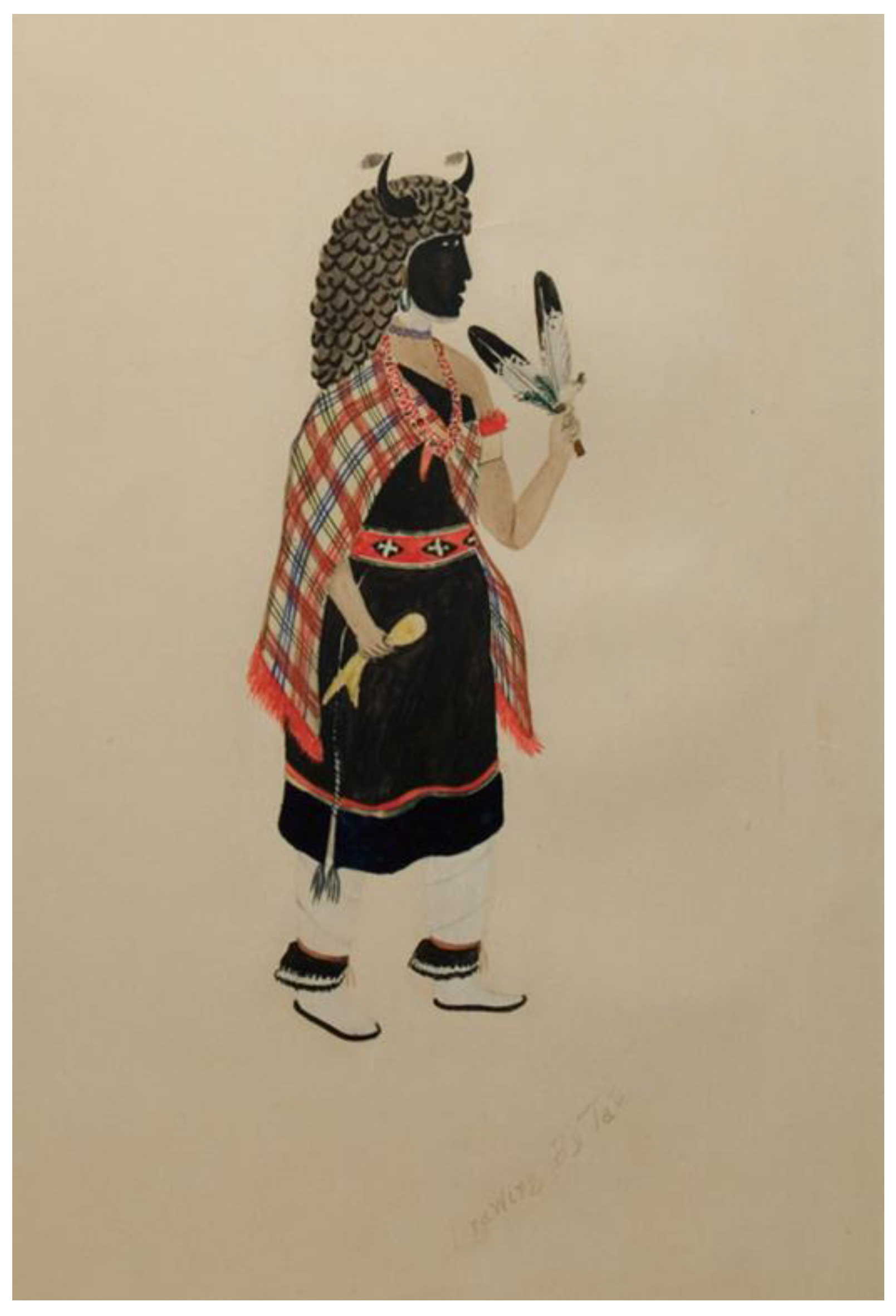
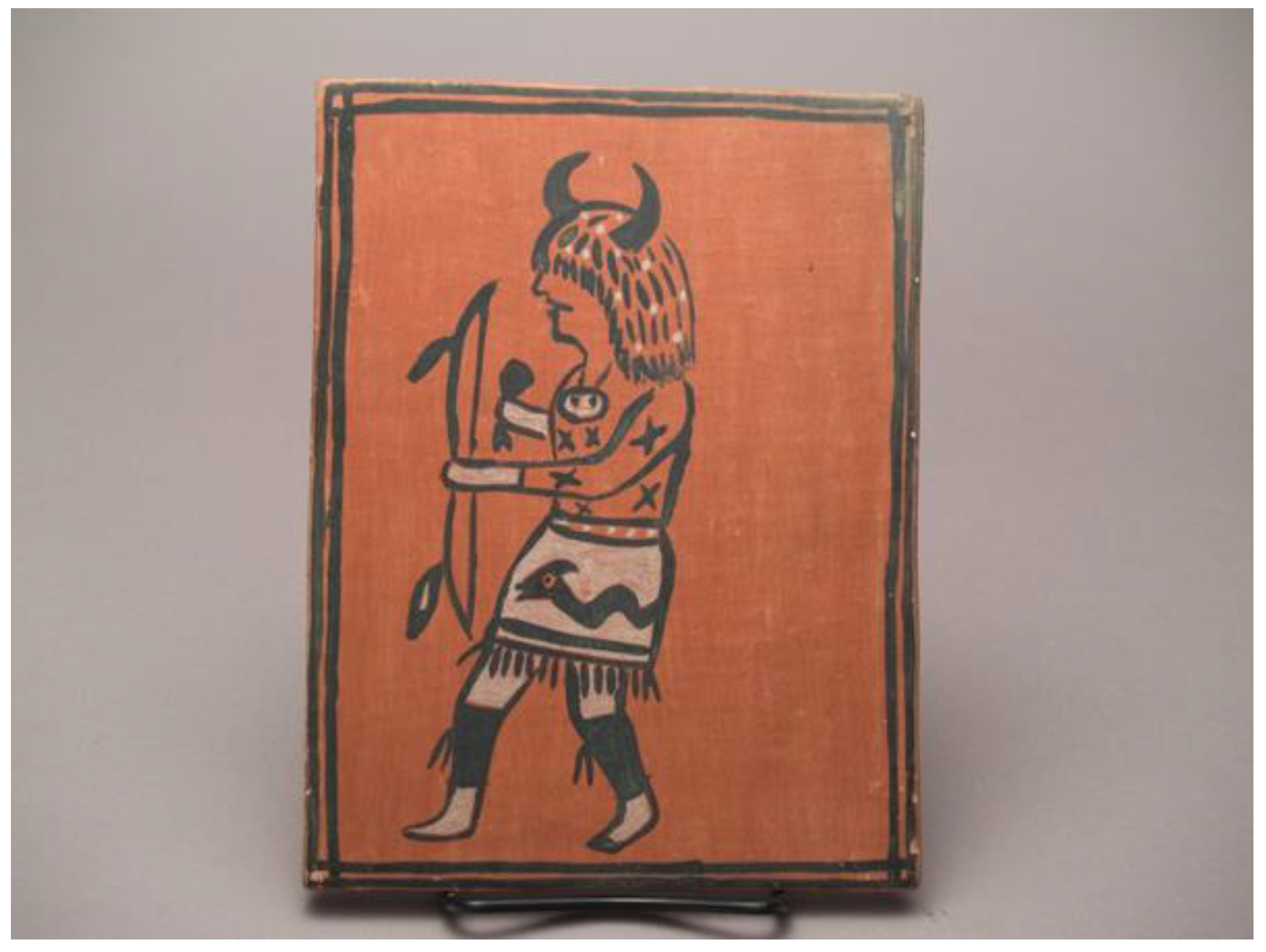
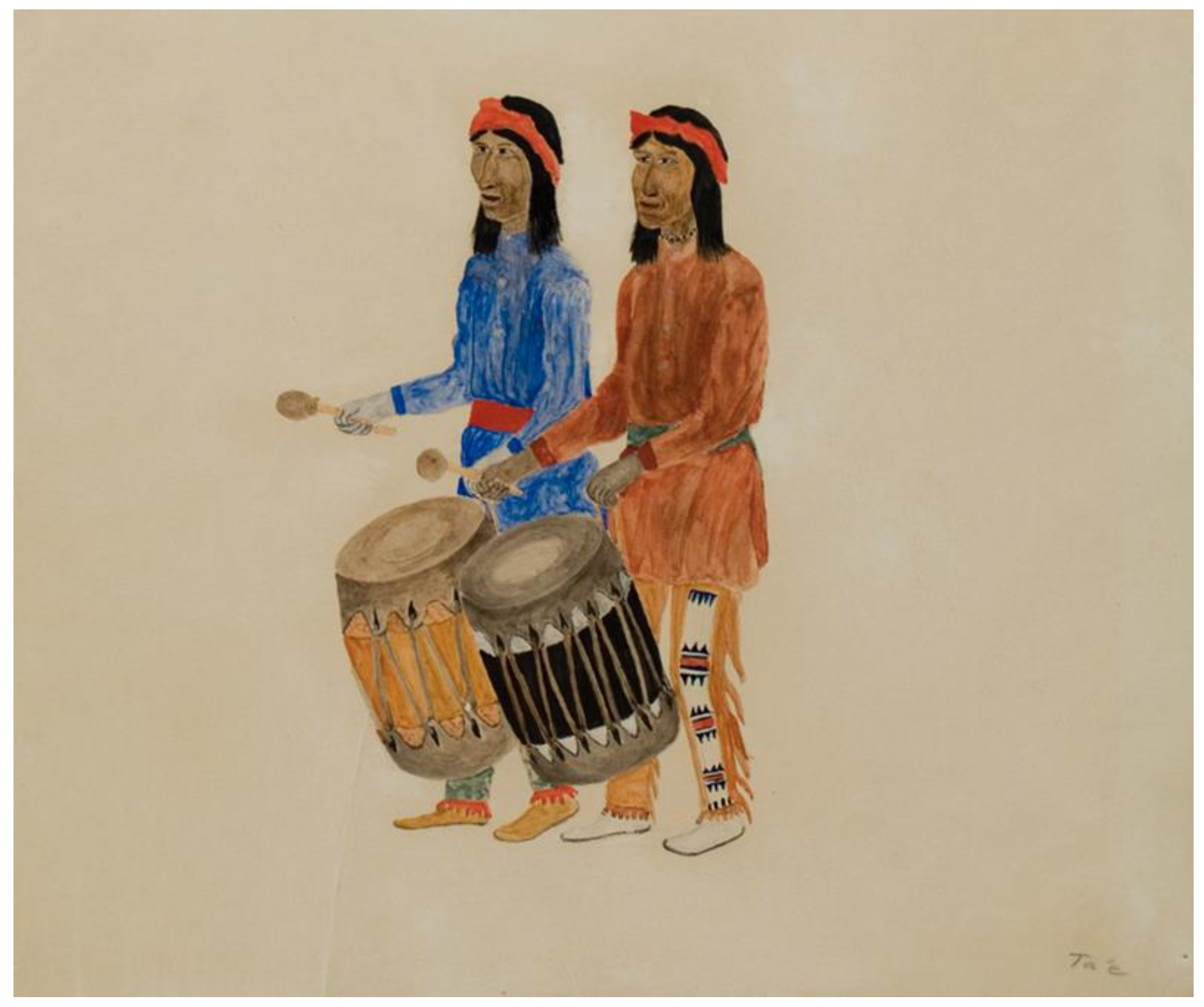
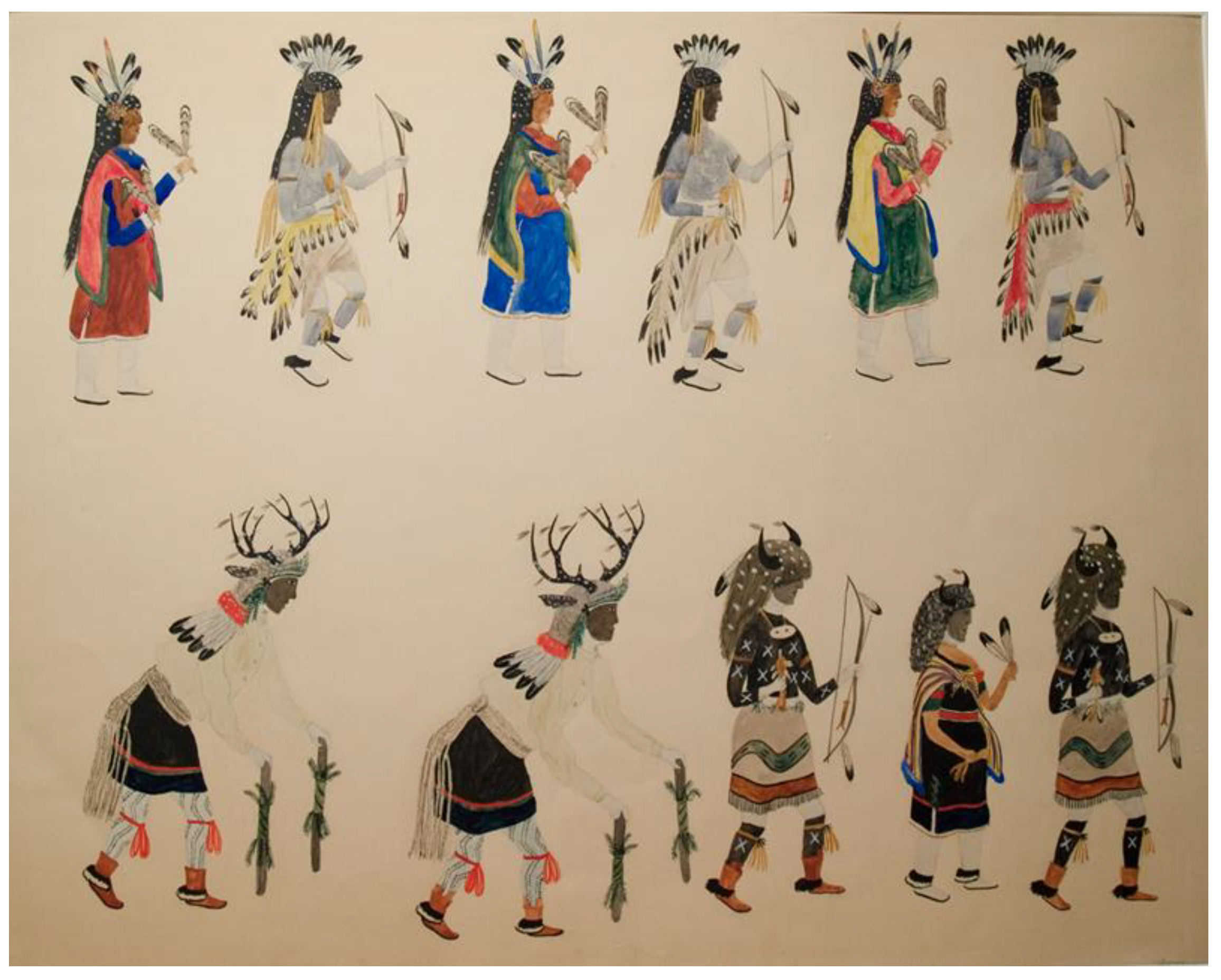
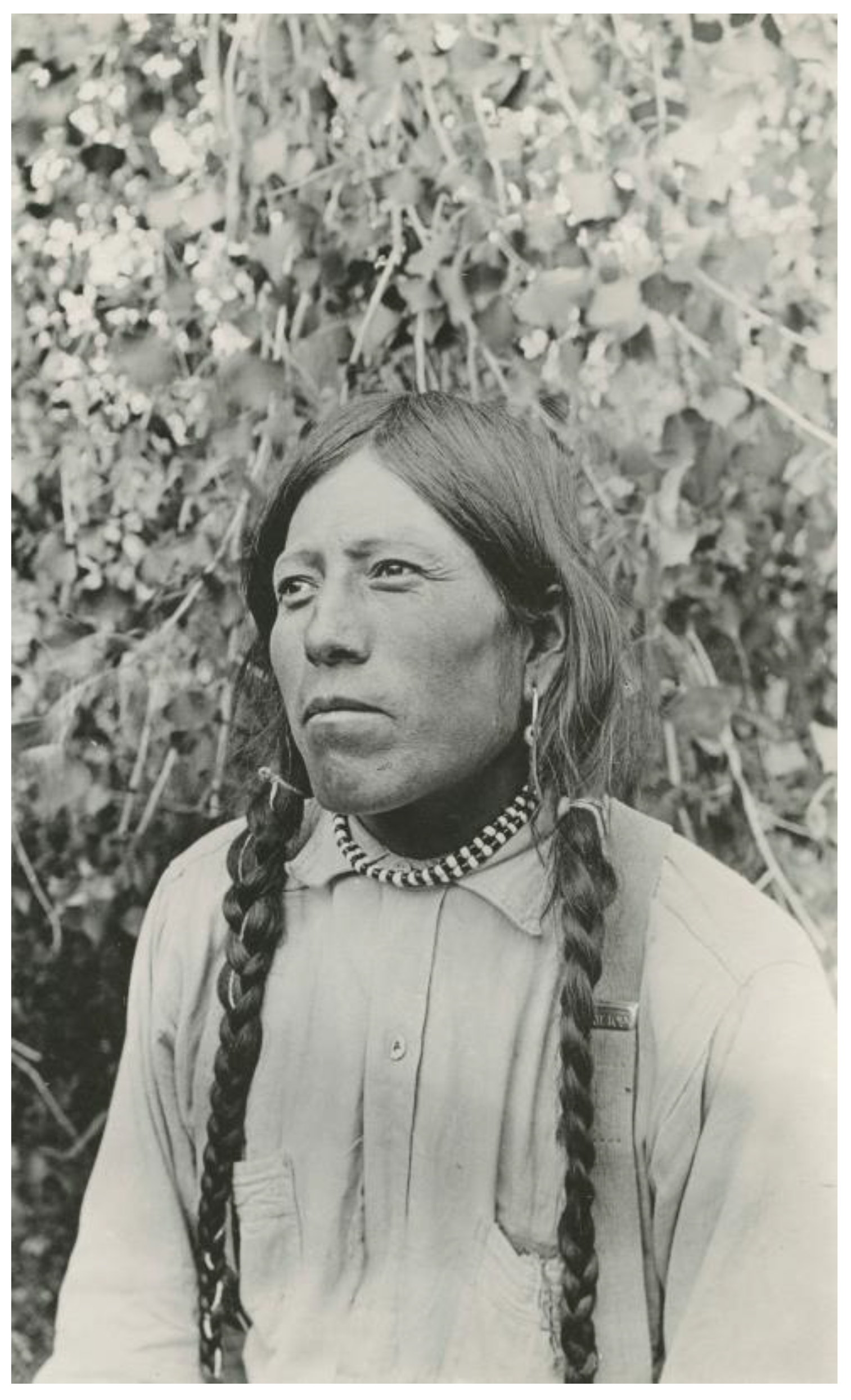
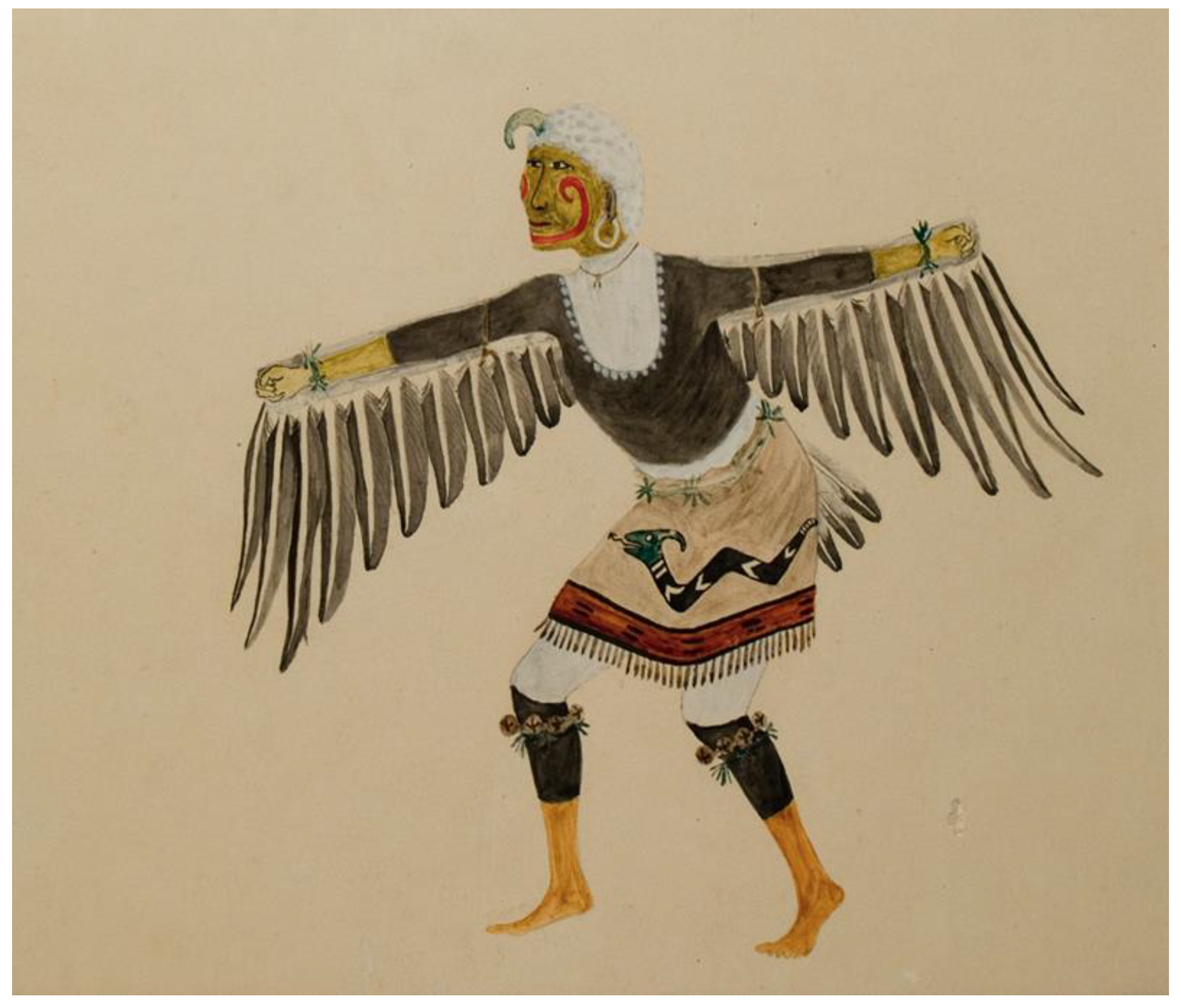
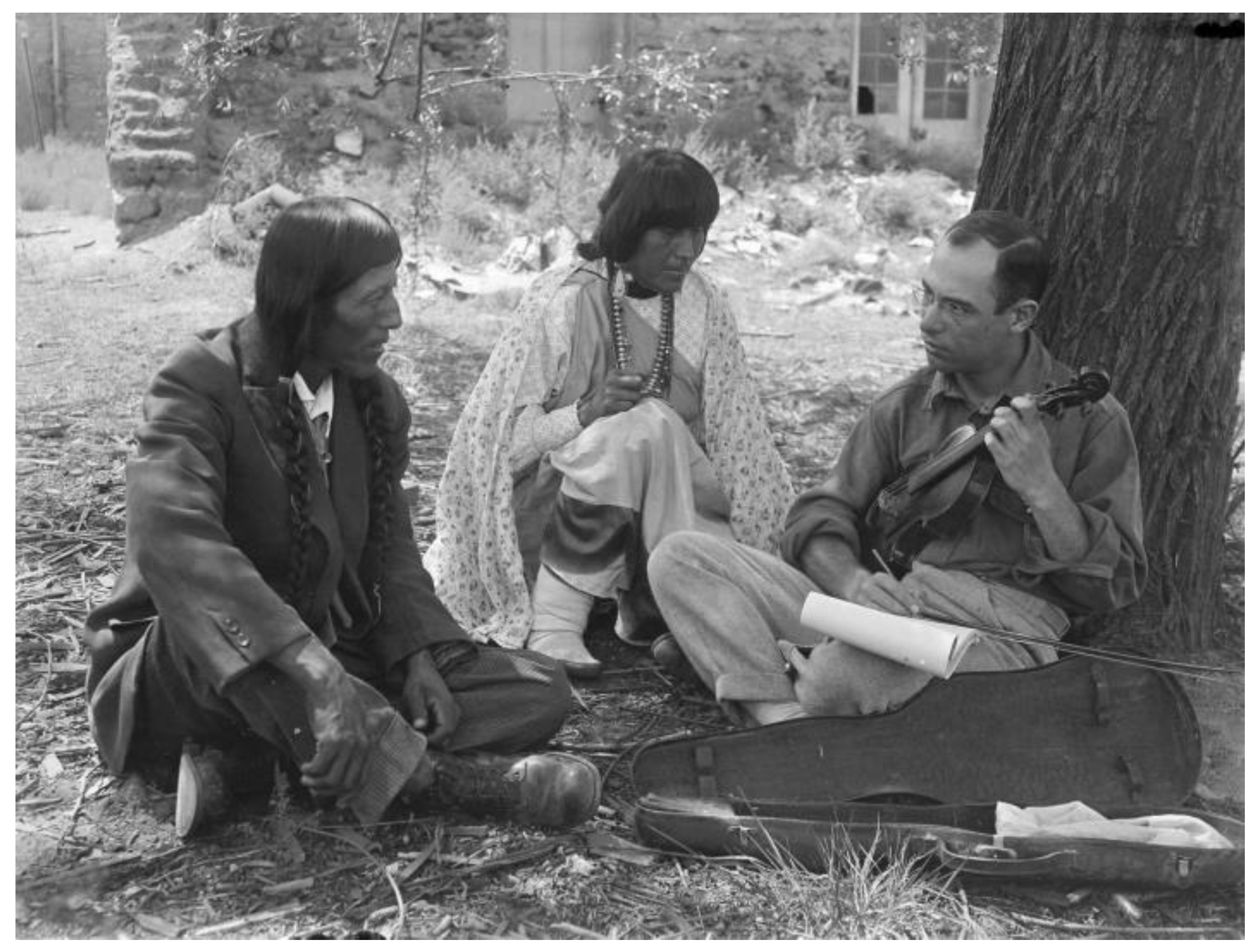
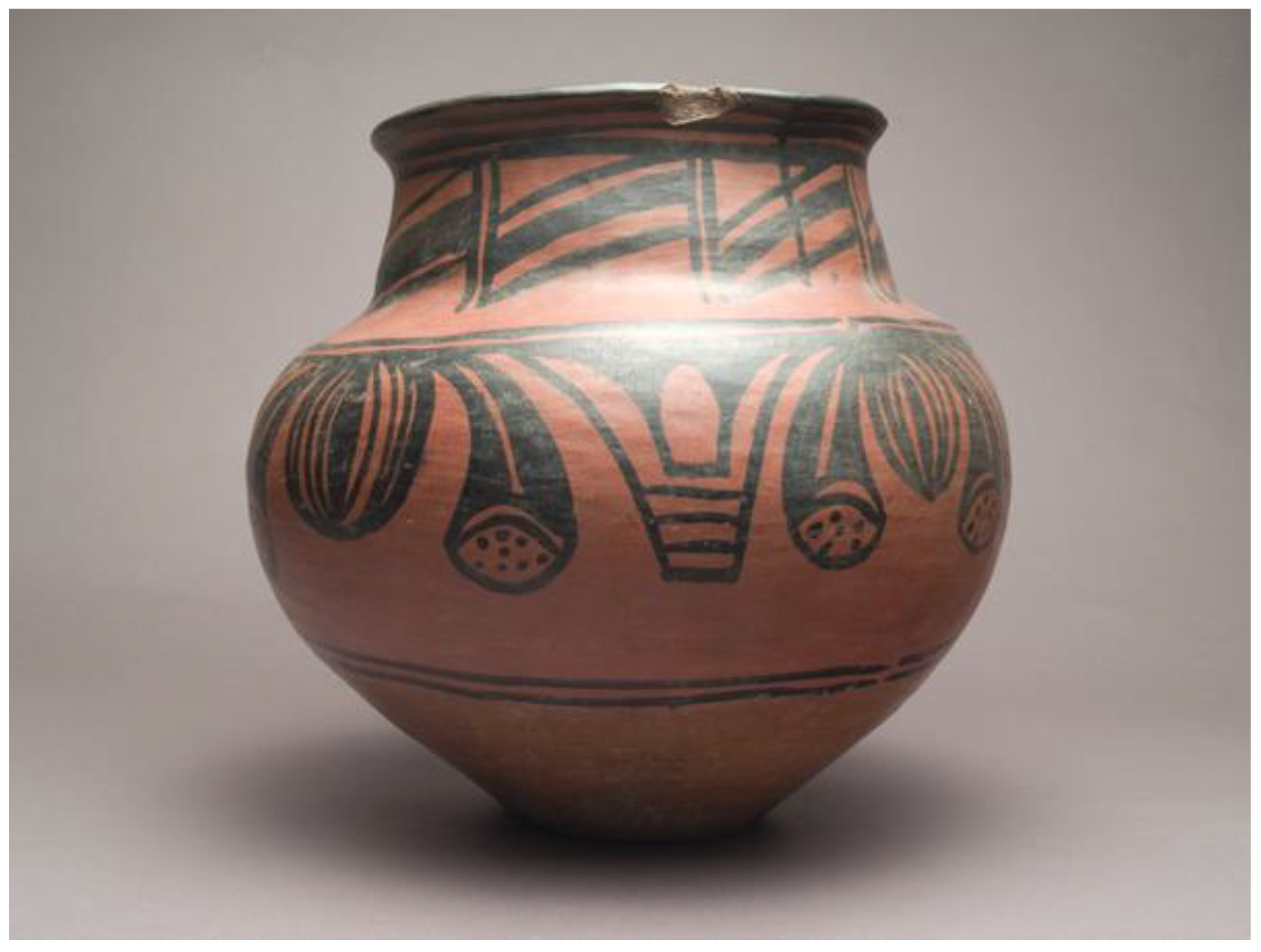
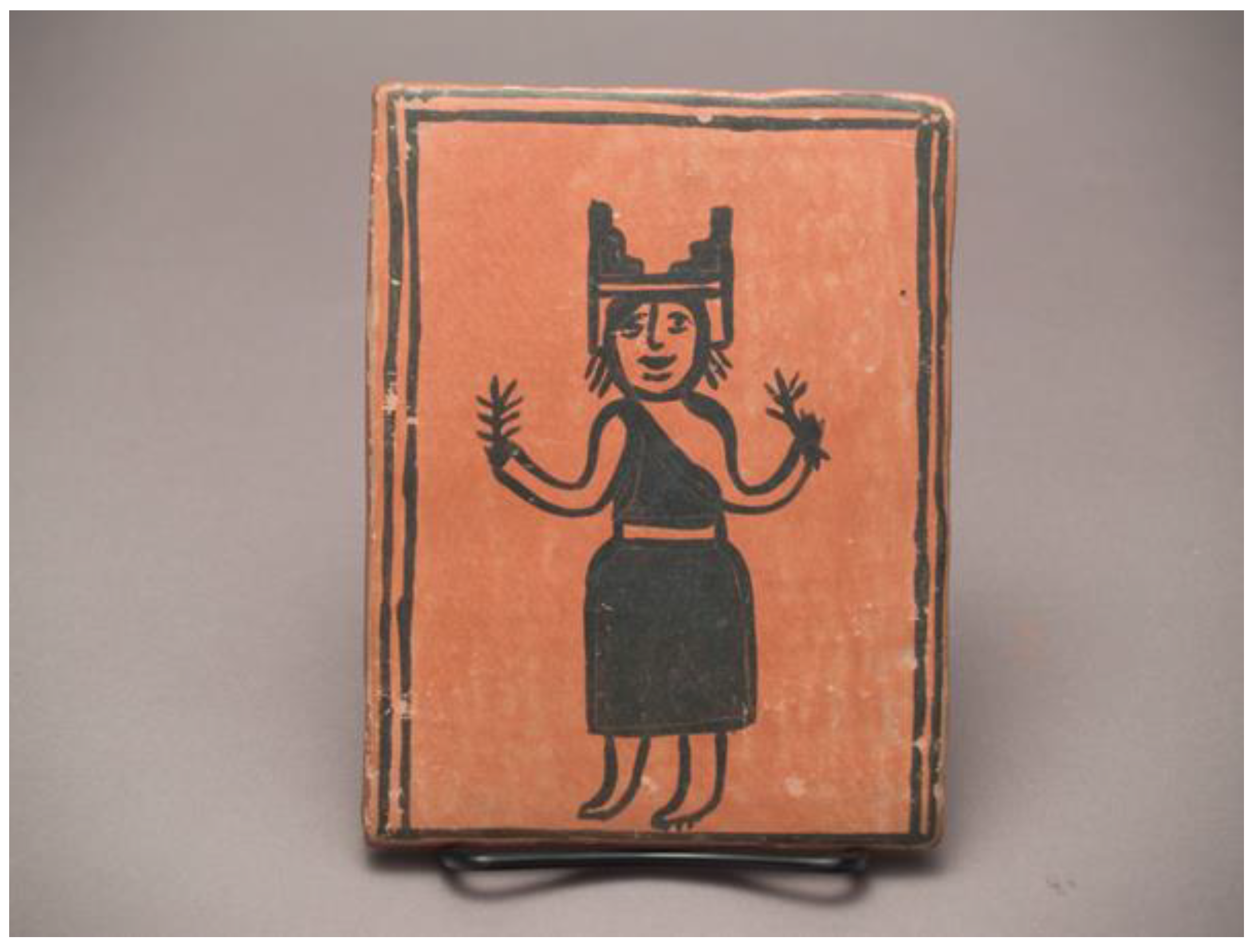
© 2020 by the author. Licensee MDPI, Basel, Switzerland. This article is an open access article distributed under the terms and conditions of the Creative Commons Attribution (CC BY) license (http://creativecommons.org/licenses/by/4.0/).
Share and Cite
Scott, S.T. Ana-Ethnographic Representation: Early Modern Pueblo Painters, Scientific Colonialism, and Tactics of Refusal. Arts 2020, 9, 6. https://doi.org/10.3390/arts9010006
Scott ST. Ana-Ethnographic Representation: Early Modern Pueblo Painters, Scientific Colonialism, and Tactics of Refusal. Arts. 2020; 9(1):6. https://doi.org/10.3390/arts9010006
Chicago/Turabian StyleScott, Sascha T. 2020. "Ana-Ethnographic Representation: Early Modern Pueblo Painters, Scientific Colonialism, and Tactics of Refusal" Arts 9, no. 1: 6. https://doi.org/10.3390/arts9010006
APA StyleScott, S. T. (2020). Ana-Ethnographic Representation: Early Modern Pueblo Painters, Scientific Colonialism, and Tactics of Refusal. Arts, 9(1), 6. https://doi.org/10.3390/arts9010006



